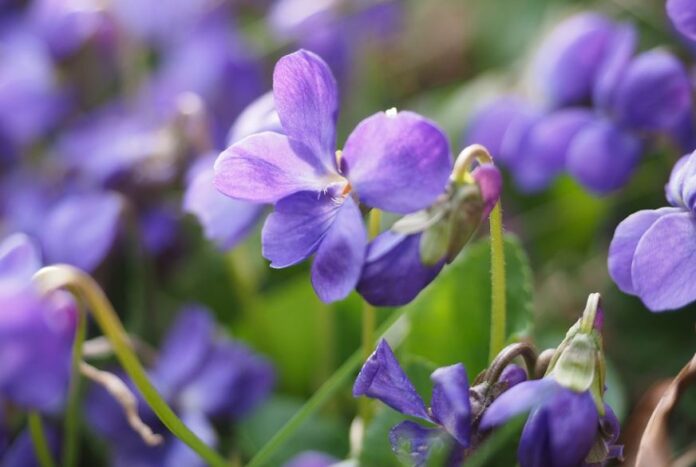
Violets have been known for many years. The Greeks cultivated them earlier than the 500 BC. Violets were also used for different purposes. They were used even as herbal remedies. There are different types that you can plant in your garden or you can have in pots.
In this article, we will give you tips not only about how you can grow violets but also we will give you tips if you want to keep them in pots and how to take care these lovely flowers. Let’s have a look at the different types.
Types of Violets
There are more than 400 types of violets. Napoleon Bonaparte loved this flower that is why he covered his wife’s grave with the purple blossoms of the violet. Below we look at the characteristics of different types.
Below we will write the most common violet types
-
- Appalachian Blue
- Birdfoot
- Canadian
- Common Dog
- Downey Yellow
- Early Blue
- Field Pansy
- Heath Dog
- Northern Bog
- Sweet Violet
- Yellow Pansy
Appalachian Blue Violet
This type of violet is also known as Viola appalachiensis. It is a rare type that has blue petals. It grows from Pennsylvania to North Carolina only. You won’t find it anywhere else. It blooms from mid to late spring. What is great about this violet is the fact that the center of the flowers is white and it will grow up to 4 inches.
The petals of the Appalachian Blue have tiny hairs and are slightly toothed. You will find this type close to the streams, in the woods and in coves of mountains. It is a wonderful variety that will make your garden unique.
Birdfoot Violet
You can find this variety of violet with the name of Viola pedate. The color of the leaves is that of the levanter and the stamens are orange. It can grow up to 7 inches tall. The leaves of this violet are basal, they are lobed and what makes it different from the other ones is the fact that it is dissected in 3 parts.
The petals of this variety have an irregular shape. They are 3 inches wide. You can find this variety in open areas. You will find them in dry woods and Eastern parts of the U.S. There is a possibility that the upper petals might be darker.
Canadian White Violet
Canadian white is also known as Viola Canadensis. This variety of violet will produce blossoms from spring to summer. You will find it in the woods. What makes this type unique is the fact that the shapes of the leaves look like a heart. They are toothed and the petals are white. The center is yellow and it has streaks.
Common Dog Violet
This variety is also known as Viola riviniana. It will give beautiful blossoms from late spring to early summer. The color of the flowers is purple. It has yellow foliage and it can grow 12 inches tall. The best way to grow it would be the shade.
It doesn’t have any scent but it is beautiful. You might find it by another name, the Dog’s tooth. You will find it in grasslands and in woodlands. It is a very beautiful variety that will make your garden look perfect.
Downey Yellow Violet
The Downey yellow violet is also known as Viola pubescens and smooth yellow violet. It can grow up to 12 inches tall and it is a herbaceous perennial plant. Its leaves are toothed and they have the shape of a heart. The petals have a yellow color. There are also brown markings at the base.
You can find this variety everywhere in the U.S. The ones that grow in the Rocky Mountains might have irregular petals. Their width can reach 1 inch. This variety can also make your garden look wonderful.
Early Blue Violet
Early blue is a violet that is also known as viola adunca or even hooked spur. It will grow up to 4 inches tall. This type has a bluish-purple color and there are lines at the 3 petals that are at the bottom. Its leaves have a shape of a heart. You can find this type in open fields. Its color is just amazing.
Field Pansy Violet
Field pansy or else viola bicolor is a herbaceous annual. You can find this type of violet in the northeastern U.S. It blooms during the spring. What is different with this flower is that its leaves have blades and stipules that divide into lobes. It can grow 12 inches tall.
The color of this variety can be white or blue and you will also find yellow markings. It is a great combination that makes it look amazing. Don’t forget that you can plant more than one variety and you will have wonderful results.
Heath Dog Violet
This type of violet is also known as viola canina. It is a perennial one and can grow up to 16 inches tall. Its petals are blue and they form a heart. Its leaves are quite shiny; they are also toothed and short-tapered. Heath dog will produce blossoms from May to June.
This type has another type too, the viola ruppii. This type gives blossoms from June to July. You can find this variety in grasslands, open forests, and roadsides. You can combine both of these types and plant them in your garden.
Northern Bog Violet
Northern bog has the name of viola nephrophylla too. This type grows in the northeastern part of the U.S. Its petals are blue, purple, or white. Its leaves can be unlobed or lobed but they never split into leaflets. Its color is simply amazing and you will love it.
Sweet Violet Violet
You might also know sweet violet as viola odorata. This variety can grow 10 inches tall and 18 inches wide. It will grow blossoms from late winter to early spring. Its petals are quite delicate and they have an amazing fragrance.
Its color can be either dark purple or blue. You can also find it in white, pink and lilac. If you will choose to grow this variety, have in mind that it needs shade in order to grow. Additionally, it needs moist and well-drained soil. It’s a lovely choice.
Yellow Pansy Violet
Yellow pansy can be found with the name of viola pedunculata and California golden violet. What makes this violet special is the fact the color of the petals are yellow or even orange. It will produce blossoms from March to April. It can grow 6 inches tall and its leaves have more than 2 inches width.
If you live in a very hot climate choose to plant it in a place with partial shade. It has an amazing fragrance and at their bottom, you will find markings that have brownish or even purple color. It is a wonderful variety to choose from.
Preparing the Soil Before Planting Violets
In order to grow healthy and beautiful violets, you need to follow these simple tips. You need to know the hardiness zone that you are at. It will grow best from 5 to 8 USDA zones. You should check that before you choose them.
What you also need to have in mind is the soil. The soil that you plant them should be free of diseases. Additionally, you should make sure that the water can drain well. Take proper care of the soil and add compost and fertilizer to ensure that the soil and the violet plant will thrive.
Another thing that you should do is to check the pH of your soil. Violet plants need the soil to be slightly acidic in order to grow. You can do a soil test in order to check the right pH. The right value should be from 5.5 to 7.
In case the pH of your soil is more than 7 then you could use the following materials to lower it. You could use sulfur, iron sulfate, and elemental sulfur. You can find these materials in garden centers.
The final thing that you should do is to choose a place in your garden that will have partial shade. When you plant them leave from 6 to 12 inches between them in order to grow properly. Also need the shade during the summer time and in winter they need the sunlight. Have this in mind when you plant them.
Planting the Violets
The best season to plant the violets would be the late fall. You can also plant them in pots and then transfer them to the soil. If you do that do it from 6 to 8 weeks and transfer them after the last frost has passed.
What you need to do next is to add mulch. The soil in this way will stay damp. As a result, the roots will remain cool for a long time and this is exactly what we want. Once you plant them, you need to fertilize it.
You can buy a fertilizer or you can use manure or compost. Fertilize the plants when you plant them and after that repeat the process once per month. In this way, you will have healthy violet plants and you will protect the soil too.
How to Take Care of Violets
Taking care of your amazing violets is an easy task. All you need to do is to make sure that the soil is dump. You will water them once or twice a week and you should make sure the soil is well-drained. Otherwise, it will rot if you water too much or if the water doesn’t drain.
You will also need to remove the blossoms that are spent. You should trim them and then the next ones will bloom. Finally, you should use a liquid fertilizer during the late autumn. Violet plants are perennials and they can live for more than 2 years. When the spring comes, add liquid fertilizer in order for to get the right nutrients.
Violets in Pots
Growing violets isn’t difficult at all. Plants Violet germinate slowly so it would be a good idea to plant the seeds indoors in a pot. You can keep them in a pot and have them inside your house if you want to. You have to start this process from 10 to 12 weeks before the last frost.
You need to use pots that will have holes and trays. Fill in the pots with a potting mix. Place the seeds in the soil and cover them with 1/8 of the acquired potting mix. What you need to do next is to cover the tray with a plastic bag and keep it in a warm room. The temperature should be 70 degrees F.
When you water the plant make sure that it remains moist. Once the seeds are ready, remove the plastic bag and place the pot close to a window that will have plenty of sunlight. Make sure that the violet seedlings will be from 6 to 8 inches apart. After that, you can transfer them to bigger pots.
Once you plant them in pots that you like the only thing that they need is the sun when it isn’t too hot. If it’s too hot, move them to a place with partial shade. You can use a fertilizer in spring and fall.
Violets aren’t only beautiful, they are pest-resistant too. Take good care of them and if you see aphids use neem oil or use a soap spray and they will be fine. Taking care of them is quite easy.
Violets Propagation
For the propagation, you need to follow the same process that we mentioned above with the pots. Once the seeds are ready and the last frost has passed you will be able to transfer and plant the seeds outdoors.
When you plant them, leave 6 inches apart. As we mentioned earlier, you can plant more than 1 variety and you can create a beautiful garden with amazing violets. Which variety you’ll choose is up to you.
Conclusion
Violets are the perfect flowers. You can plant them not only in your garden but also indoors in pots. Wherever you choose to have them they will only make the place more beautiful. There is a big variety that you can choose from.
Taking care isn’t difficult at all. If you follow our tips you will have healthy and amazing flowers that will have an amazing fragrance too. The choice is yours. Enjoy planting them and taking care of them.







![Rose Names And All Rose Types – The Most Detailed Guide [2022] rose names](https://www.yardious.com/wp-content/uploads/2018/05/rose-names-100x70.jpg)











